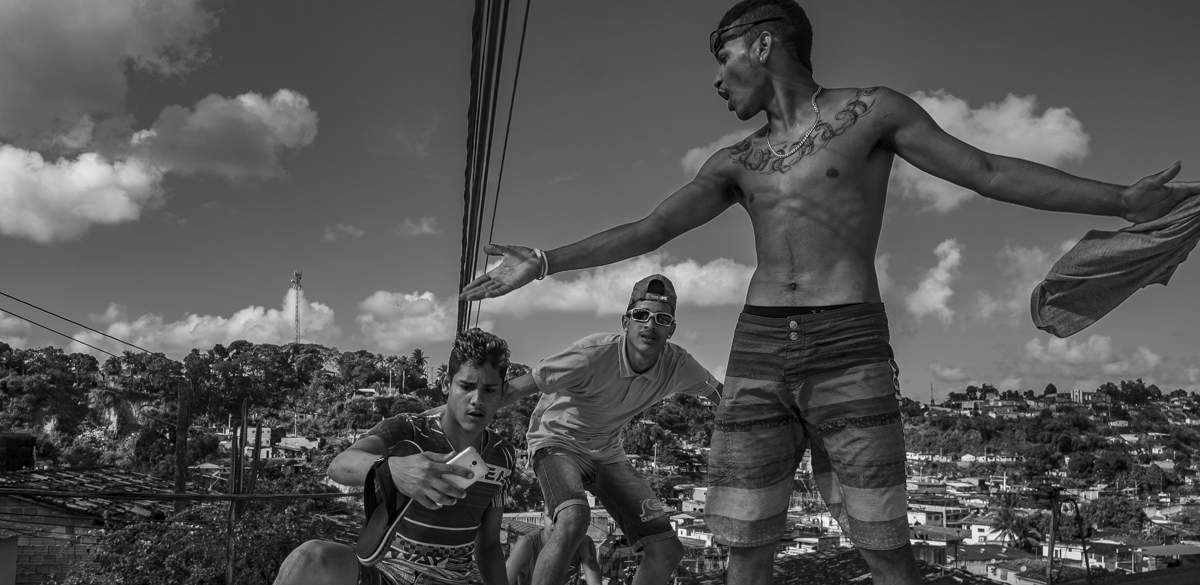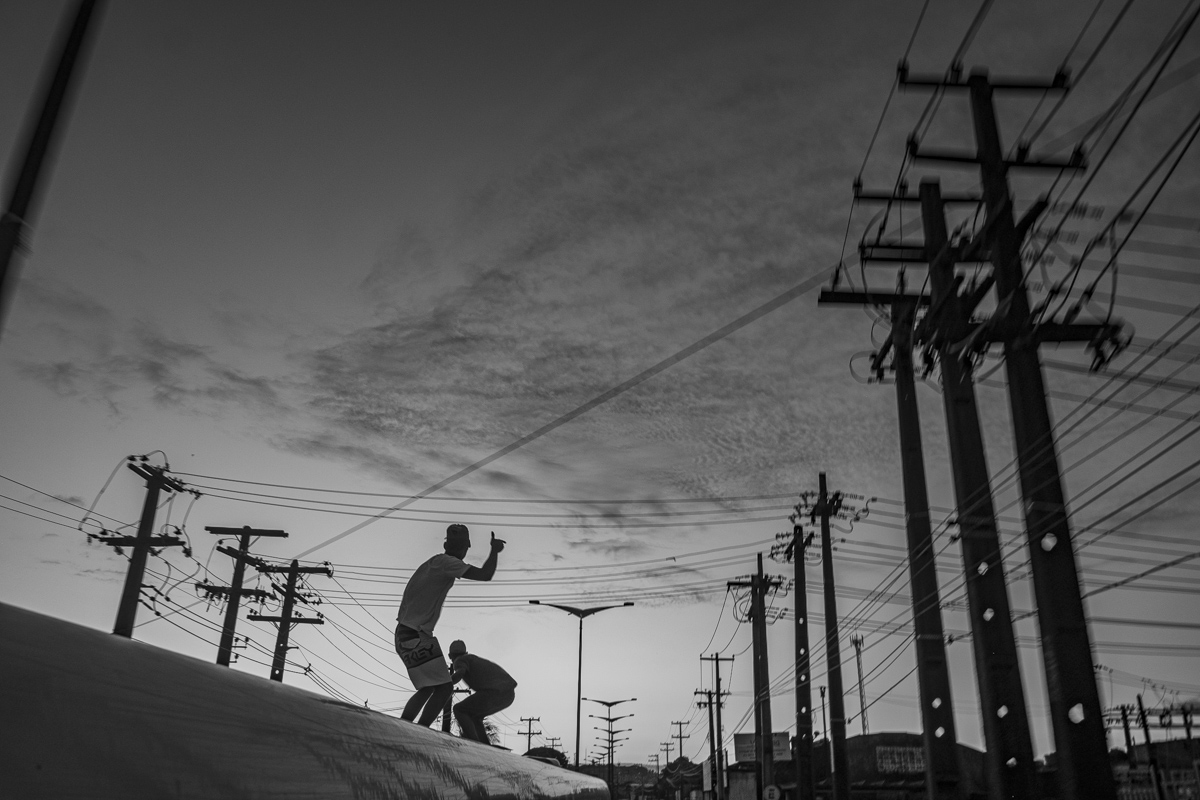Going to the edge makes work a little more thrilling

OLINDA, RECIFE, BRAZIL: AUGUST 2017: Marlon dos Santos, leader of the LDS group, was shot and killed near his home in March 2018. The acronym LDS stands for "Crazy People of Surf", a group of young friends who live in the suburb of the city of Olinda and have as a collective hobby surfing on top of moving buses. The group's meeting point is the Xambá Bus Terminal, built as a counterpart to the investments made in the 2014 World Cup in Brazil. CREDIT: Victor Moriyama
What makes risk fun? Is it knowing you can beat it? Is it competition? Is it a means of advanced self-actualization beyond what Maslow prescribed in your Psych 101 class?
Taking on risk is part of your life if you’re a leader, especially with an entrepreneurial objective. And it’s probably part of what gets you up in the morning.
A brush with danger can be motivating.
I feel this exhilaration when I’m on top of waves at my local surf spot riding my socially acceptable surfboard. But youths in Olinda, Brazil took this to a whole new level, eschewing boards for surfing crouching atop public transit buses.
Recently, I saw a photo essay on the subject, titled “Living on the Margins, Surfing on the Buses” in the New York Times. I was struck by the imagery of young men riding the sides and roofs or the city’s buses, ducking overhead cables, clinging to any grip they can find to take curves and riding the bus like a lumbering long board careening through Olinda. It looked dangerous, but the locals had mastered their sport.
Redefining danger as sport has been happening throughout history. The common element is “the high” of pulling off risky behavior.
Stephen Lyng, the sociologist and journalist, associated with Hunter S. Thompson, gave this a name: edgework. It suggests going to the boundaries of safe or socially acceptable behaviors for sheer exhilaration and, maybe, bragging rights. Edgework got on my RADAR while writing my doctoral dissertation that centered around the performance of an ocean yacht racing team and the dangerous and stressful conditions it faced.
Tip 1:
As a coach, I’m drawn to the concept, because it’s so useful in helping clients achieve awareness and optimum mental performance zones more consistently and easily.
Head for the edges of your work
So, I was equally impressed by the job of photojournalist Victor Moriyama who shot the bus surfing essay. He hung out with the surfers for a week for a compelling social commentary about urban kids with limited economic opportunities.
The surfers are edgeworkers, but so is Victor with his art. In fact, Victor’s title, “Living on the Margins,” works as a definition of edgework. It’s not a sport for Victor, it’s his life’s work and part of who he is. And it’s his brand that keeps his work in demand.
As an award-winning photojournalist he seeks out danger and risk, whether it’s a war zone or climbing the Amazon Tall Tower Observatory. Victor works around the world for major news organizations on assignments that he suggests, most often with an element of danger.
“If your pictures aren’t good enough, you aren’t close enough,” is a well-known mantra.
Victor gets as close as possible to whatever the action is to authentically capture a moment even when he’s hanging on the roof of bus. The quest for powerful images means sometimes you get on-the-job training in combat, climbing dizzying heights or avoiding hungry jaguars in a forest.
“The work in the interior of the Amazon rainforest is, without a doubt, the most physically challenging,” said Victor. “Those jobs require physical preparation and fatigue management. The heat, humidity and the imminent danger of wild animals and criminals who work in illegal deforestation make up a mentally and physically stressful scenario.
“I like the risk and the adrenalin, and it becomes something normal for us. Around protests, fires, or some other dangerous situation, we have a different way to measure the risk,” said Victor. “When we’re covering a protest and the tear gas bombs go off, the crowd run away, but we [photojournalists] run toward the bombs.”
Tip 2
In edgework, the risk becomes a peripheral factor that must be monitored, but it can’t inhibit the goal.
Practice, preparation and skill defocus the risk
“We look in the camera’s viewfinder and feel somehow distant and protected from what we’re photographing,” said Victor. “We get so focused and focused on getting good images that we somehow feel removed from danger. It never came into my mind that I could die on the bus – I just wanted to do the best picture I could. I never think about fear.”
In Victor’s case, it’s his passion.
“I normally pitch the stories that I want to cover,” said Victor. “When I pitch my own stories, they’re connected to my heart, and I’m pitching stories all the time, most often concerning social inequality and the environment.”
Tip 3
As is common with edgeworkers, Victor takes it seriously with a lot of preparation that mitigates the risk. Despite what you might think, I’ve also found that edgework people are the safest while they look at risk differently.
Takeaways from the edge
Accounts like this sound exactly like those of edgeworkers I’ve met in extreme sports, but there are also analogies among people I’ve worked with in the arena of entrepreneurial ventures where the stakes are personal fortunes, reputations and careers.
With instinct and intuition, they read the environment. For them it’s fulfilling and essential. It’s part of what keeps them in business.
Entrepreneurs can seem crazy, but there’s nothing pathological about pushing boundaries for your goals. It’s a healthy manifestation of a human need. It’s part of being an actualized human and it can be harnessed and refined improve performance even in less life-and-death contexts, e.g., business leadership and deal making.
Coaching notes:
What comes to mind as you digest what you just read? Does this apply to you? If so, what are the ‘edges’ of your work that keep you coming back for more?
Check out Victor Moriyama’s work
Victor’s doing some amazing work. You can see his portfolio and hire him here. Follow his Instagram here.

OLINDA, RECIFE, BRAZIL: AUGUST 2017: The acronym LDS stands for “Crazy People of Surf”, a group of young friends who live in the suburb of the city of Olinda and have as a collective hobby surfing on top of moving buses. The group’s meeting point is the Xambá Bus Terminal, built as a counterpart to the investments made in the 2014 World Cup in Brazil. CREDIT: Victor Moriyama

